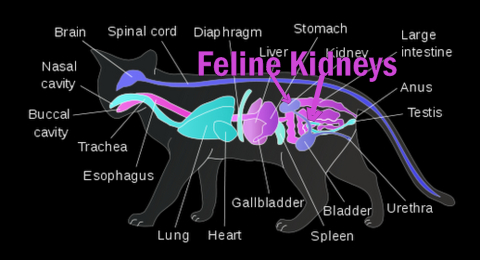Vet 101: Understanding Feline Kidney Disease – Part 2
Guest post by Dr. Letrisa Miller DVM.
Last week we had a look at the big picture of kidney disease and the International Renal Interest Society’s classification system IRIS. This week’s topic is early kidney disease. The first two stages are often referred to by clinicians as kidney insufficiency because, while full kidney function is not present, clinical signs usually do not involve signs associated with illness.
Stage 1 kidney disease is less easily defined than the other stages because there are no blood abnormalities yet detectable to prove decreased kidney function.
Unfortunately, we do not yet have a way to detect kidney disease before approximately 60% of function has been lost using blood tests. This means that most stage 1 disease is never identified.
The most common reason for a cat to be classified as having stage one renal disease is decreased concentration of the urine (dilute urine) without any other abnormality seen. It can be difficult to tell the difference between a cat that is taking in a lot of water by choice or through it’s diet and one that has a kidney problem at this stage. The only test that will tell a veterinarian for sure in this instance is to restrict water intake and see if the cat can produce concentrated urine when water intake is reduced. If the urine remains dilute in the face of dehydration, there is kidney disease. This test is very rarely used because it can cause illness through dehydration, as well as it can be considered to be uncomfortable for the patient.
Other reasons for stage 1 classification can be some abnormality of the kidney that can be detected by palpation (feel) and/or ultrasound exam or persistent presence of protein in the urine.
Stage 2: Stage 2 kidney disease is characterized by mild elevation of the compound called creatinine in the blood (1.6 to 2.8 mg/dl) and, in most cases, dilute urine.
Creatinine is a by-product of muscle metabolism and has nothing to do with the kidney except that it is excreted by the kidneys. Creatinine is used to measure kidney function because it has been found to be easy to measure and have predictable excretion rates that reflect kidney function in animals that have normal muscle mass. (Remember this, as it is important later.)
Note that in dehydrated animals creatinine can be elevated and not reflect kidney function. This can make interpretation of a single blood chemistry difficult and a doctor seeing a single elevated creatinine in a patient may decide to recheck it in a few days to weeks to make sure that it is not due to dehydration.
Blood urea nitrogen (BUN) is also often used in measuring kidney function, but it is harder to interpret as it is effected by what the patient is eating, GI disease, and other hard to control variables. BUN is more important, though, in clinical signs of kidney disease.
Cats in stage 2 kidney disease usually drink and urinate more than usual. Very often, these two symptoms are the only ones recognized by cat caretakers at this stage and usually are not noted as a problem. Because of this, most cats are not diagnosed even in this stage because the cats don’t seem sick.
Other clinical signs are usually not present, but cats in this group are at significantly increased risk of hypertension (high blood pressure) and urinary tract infections.
Because of the increased risk, cats in this group should have physical exams and lab work done at least twice a year. Lab work should include urine culture because dilution of the urine can cause lab tests for infection to be negative, while a culture will grow bacteria. Left untreated, infection can further damage the kidneys and lead to kidney failure.
Cats that are found to have higher than normal amounts of protein in the urine should be started on a drug called an ACE inhibitor such as enalapril or benazapril to help regulate the blood pressure in the kidney. This class of drug has been shown to significantly increase life expectancy in cats that have protein in the urine.
Potassium is lost in the urine and cats that have increased urination often develop low potassium levels and need a potassium supplement. There are many brands of supplements available. I favor those that use potassium gluconate because cats seem to find those most palatable.
Cats that have stage 2 kidney disease are also at increased risk of gastric ulcers in some cases and may have acidic body pH that puts their kidneys and some other organs at risk of damage. Some cats will benefit from treatment with medications like pepcid.
Many practitioners also believe that supplemental vitamin D in the form of calcitriol is beneficial in preventing or delaying imbalances in calcium and phosphorus and helps keep appetite normal. Many, or even most, cats in the stage 2 category will need only close monitoring and no medication at all. A very few will need all of the medications mentioned. The most common medication needed is potassium, and that is usually given in the food.
Overall, while the first two stages of kidney disease are worrying and require close monitoring to keep the cat healthy, the increased care is minimal and life expectancy is really not changed for the cat as long as progression of kidney disease can be stopped.
If you missed part 1, here’s the link
Dr. Letrisa Miller has a feline-only practice at the Connecticut Feline Medical & Surgery




25 Comments
how do i grow my facebook group
i really like this blog and i am trying to start my own i was wondering can you please take a look at my site and help me out how do i grow my facebook group
fortnite hack
Great, google took me stright here. thanks btw for post. Cheers!
Janelica Nagy
Any cat can develop feline kidney disease. Most cases occur in older cats, but cysts, injuries and poisoning in younger cats also lead to kidney problems. Lots of information I gather from there about my cat health…..
long jersey dress uk
You made some respectable points there. I looked on the internet for the issue and located most people will go together with together with your website.
detox pretox
I believe I checked out a different post like this one in the past. It had the exact same material and is just as well posted.
مجله علمي
Ciao ,Which CMS is the best my friends ? danke
mindy
Is it normal for my girl cat to throw up with a fur ball in her throat?
mindy
My car of 2 years old threw up and it was clear. What should I do?
Layla Morgan Wilde
see a vet if it continues.
Elden
Right here is the right site for anybody who hopes to understand this topic.
You understand so much its almost tough to argue with you (not that I
personally would want to…HaHa). You definitely put a new spin on a subject
that’s been discussed for ages. Wonderful stuff, just wonderful!
pheromonoes
pheromonoes [url=http://buypheromones.webs.com/]pheromones termites[/url] wiyaguv, pheromones amazon [url=http://usepheromones.webs.com/]pheromones and hormones[/url] rnm5jdjav28hdke, 9960 [url=http://pheromone101.webs.com/]wingman x pheromones[/url] pheromones cologne for men
Lisa Martin
Very useful info! It is rather difficult to observe these symptoms.
There are now home-tests to check for kidney disease, the Pawcheck tests or the Petcheckup. Please pass on the information.
sue brandes
Thank you so much. Very imformative. I just found out my kitty had high blood pressure on top of thyroid disease. And I know the vet is also watching the kidneys.
Claude West
Nice article but beyond genetic issues, diet is the leading cause of CKD in felines. Domestic cats are not fed a species specific diet that would support their health and immune system. Stop feeding your cat dried food on a 24/7’s basis is the first step towards helping your cat avoid these diseases in their mid life.
Caretaker_Cat "Lilly"
Re this info: Because of the increased risk, cats in this group should have physical exams and lab work done at least twice a year. Lab work should include urine culture because dilution of the urine can cause lab tests for infection to be negative, while a culture will grow bacteria. Left untreated, infection can further damage the kidneys and lead to kidney failure
This is very important to know. I just took one of my kidney failure cats to the vet who was urinating blood. Vet claimed no bacteria in urine. no culture done. Convenia injectipn given. Two week later, stil peeing blod. Took cat back. Vet did another urine sample . Suspected kidney stones so I agreed to an x ray. no stones visible. I asked about a culture but since vet said due to cat being on convenia it would have to wait 3 weeks. so i asked for a different antiobiotic. It’s been a week and i hope this clears it up. I don’t know how much a culture for a cat is, but perhaps another vet 101 could discuss this and whether convenia is best first choice for urinary infections and what are best antibiotics to use.
boomermuse
Thanks for the info. I’ll pass on the message. With my kidney cat Merlin, he is seen by his vet every three months or so.
Skeeter and Izzy
You’re the best Dr. M! Thank you and Layla both for helping us to learn so much more important information about our kitties! Luvs and purrs Skeeter and Izzy >^..^<
Abby
This was an easy to understand explanation. Thank you for sharing. Good information for all cat owners.
Katie and Coccolino
Really helpful, thanks for sharing.
Oink oink,
Katie and Coccolino the mini pig
Connie Marie
Great article, so much good information on terrible disease, I didn’t know very much about. Happy to know there is so much to do for it.
da tabbies o trout towne
thanx for de post today guys…it containz veree help full info..!!
Tamago
Great information. I will read again. It’s very difficult to detect early but I try not to miss the small symptoms.
Bernadette
It’s so important to be aware of minor symptoms–or what seem like minor symptoms, since cats hide illness so effectively.
Kathryn
Wow. Bookmarking this one. Such great info, and of course, I want the boyz to stay healthy during their second decade.
I am impressed with the varieties of conditions the professional vet food treats – crystal dissolution/urinary (my boyz); kidney; diabetes; liver; weight loss formula; weight gain formula; and more.
Sparkle
This is very useful information! Kidney disease is so common amongst us kitties and most humans don’t know much about it.